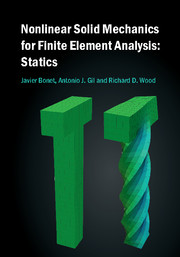Book contents
- Frontmatter
- Dedication
- Epigraph
- Contents
- Preface
- 1 INTRODUCTION
- 2 MATHEMATICAL PRELIMINARIES
- 3 ANALYSIS OF THREE-DIMENSIONAL TRUSS STRUCTURES
- 4 KINEMATICS
- 5 STRESS AND EQUILIBRIUM
- 6 HYPERELASTICITY
- 7 LARGE ELASTO-PLASTIC DEFORMATIONS
- 8 LINEARIZED EQUILIBRIUM EQUATIONS
- 9 DISCRETIZATION AND SOLUTION
- 10 COMPUTER IMPLEMENTATION
- Bibliography
- Index
3 - ANALYSIS OF THREE-DIMENSIONAL TRUSS STRUCTURES
Published online by Cambridge University Press: 05 June 2016
- Frontmatter
- Dedication
- Epigraph
- Contents
- Preface
- 1 INTRODUCTION
- 2 MATHEMATICAL PRELIMINARIES
- 3 ANALYSIS OF THREE-DIMENSIONAL TRUSS STRUCTURES
- 4 KINEMATICS
- 5 STRESS AND EQUILIBRIUM
- 6 HYPERELASTICITY
- 7 LARGE ELASTO-PLASTIC DEFORMATIONS
- 8 LINEARIZED EQUILIBRIUM EQUATIONS
- 9 DISCRETIZATION AND SOLUTION
- 10 COMPUTER IMPLEMENTATION
- Bibliography
- Index
Summary
INTRODUCTION
This chapter considers the uniaxial (one-dimensional) large displacement, large strain, rate-independent elasto-plastic behavior applicable to structural analysis of pin-jointed trusses. The motivation is to expand and reinforce previous material and to introduce some topics that will reappear later when elasto-plastic behavior of continua is considered. For example, various nonlinear geometrical descriptors will be linearized, providing further examples of the use of the directional derivative.
Formulations start with the kinematic description of the motion in threedimensional space of a truss member (axial rod) that undergoes large displacements and rotations, leading to large or small strain that causes stress which may reach the limit or yield stress of the material. For simplicity, it will be assumed that the strain in the truss member is uniform. Consequently, the fundamental measure of deformation in the axial rod is the stretch λ = l/L, which is the ratio of the deformed length to the undeformed length; see Figure 3.1.
The internal forces in the truss are easily determined from simple strengthof- material considerations involving the true (or Cauchy) stress σ, defined for a truss as the internal axial force T divided by the deformed cross-sectional area a. However, for large deformation the elasto-plastic behavior is best characterized using an alternative stress known as the Kirchhoff stress τ defined as σv/V see Figure 3.1. In preparation for Chapter 6 it will be shown how the Kirchhoff stress can be derived from a hyperelastic energy function involving the natural logarithm of the stretch.
Global equilibrium equations are derived from simple joint equilibrium equations. Since these are nonlinear with respect to the position of the rod, a Newton– Raphson solution procedure is adopted which requires the linearization of the equilibrium equations. This is achieved using the directional derivative to yield the tangent matrix necessary for the solution. The tangent matrix contains the material tangent modulus, which is the derivative of the stress with respect to the strain, which for elastic behavior will emerge as a Young's modulus-like constant. However, for inelastic (plastic) cases detailed consideration of elasto-plastic material behavior is necessary.
In anticipation of Chapters 5 and 8, the concept of Total Potential Energy is introduced as an alternative way of obtaining the equilibrium equations. This involves a discussion of the stationary condition of the Total Potential Energy obtained as a variational statement which can be interpreted as the Principle of Virtual Work.
- Type
- Chapter
- Information
- Publisher: Cambridge University PressPrint publication year: 2016



